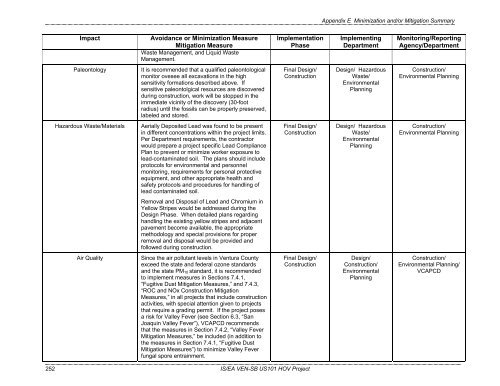Chapter 1 - Caltrans - State of California
Chapter 1 - Caltrans - State of California
Chapter 1 - Caltrans - State of California
You also want an ePaper? Increase the reach of your titles
YUMPU automatically turns print PDFs into web optimized ePapers that Google loves.
Impact Avoidance or Minimization Measure<br />
Mitigation Measure<br />
Waste Management, and Liquid Waste<br />
Management.<br />
Paleontology It is recommended that a qualified paleontological<br />
monitor ovesee all excavations in the high<br />
sensitivity formations described above. If<br />
sensitive paleontolgical resources are discovered<br />
during construction, work will be stopped in the<br />
immediate vicinity <strong>of</strong> the discovery (30-foot<br />
radius) until the fossils can be properly preserved,<br />
labeled and stored.<br />
Hazardous Waste/Materials Aerially Deposited Lead was found to be present<br />
in different concentrations within the project limits.<br />
Per Department requirements, the contractor<br />
would prepare a project specific Lead Compliance<br />
Plan to prevent or minimize worker exposure to<br />
lead-contaminated soil. The plans should include<br />
protocols for environmental and personnel<br />
monitoring, requirements for personal protective<br />
equipment, and other appropriate health and<br />
safety protocols and procedures for handling <strong>of</strong><br />
lead contaminated soil.<br />
Removal and Disposal <strong>of</strong> Lead and Chromium in<br />
Yellow Stripes would be addressed during the<br />
Design Phase. When detailed plans regarding<br />
handling the existing yellow stripes and adjacent<br />
pavement become available, the appropriate<br />
methodology and special provisions for proper<br />
removal and disposal would be provided and<br />
followed during construction.<br />
Air Quality Since the air pollutant levels in Ventura County<br />
exceed the state and federal ozone standards<br />
and the state PM10 standard, it is recommended<br />
to implement measures in Sections 7.4.1,<br />
“Fugitive Dust Mitigation Measures,” and 7.4.3,<br />
“ROC and NOx Construction Mitigation<br />
Measures,” in all projects that include construction<br />
activities, with special attention given to projects<br />
that require a grading permit. If the project poses<br />
a risk for Valley Fever (see Section 6.3, “San<br />
Joaquin Valley Fever”), VCAPCD recommends<br />
that the measures in Section 7.4.2, “Valley Fever<br />
Mitigation Measures,” be included (in addition to<br />
the measures in Section 7.4.1, “Fugitive Dust<br />
Mitigation Measures”) to minimize Valley Fever<br />
fungal spore entrainment.<br />
Implementation<br />
Phase<br />
Final Design/<br />
Construction<br />
Final Design/<br />
Construction<br />
Final Design/<br />
Construction<br />
252 IS/EA VEN-SB US101 HOV Project<br />
Appendix E Minimization and/or Mitigation Summary<br />
Implementing<br />
Department<br />
Design/ Hazardous<br />
Waste/<br />
Environmental<br />
Planning<br />
Design/ Hazardous<br />
Waste/<br />
Environmental<br />
Planning<br />
Design/<br />
Construction/<br />
Environmental<br />
Planning<br />
Monitoring/Reporting<br />
Agency/Department<br />
Construction/<br />
Environmental Planning<br />
Construction/<br />
Environmental Planning<br />
Construction/<br />
Environmental Planning/<br />
VCAPCD

















